Discussion
First you have to unify your data into a single table. This can be done with a kind of outer join, if you're familiar with SQL. See How to join (merge) data frames (inner, outer, left, right)?. The resulting NAs (for records which failed to join to the opposite table) must be replaced with zeroes in order for the final call to barplot() to work.
You must then derive a matrix in the format required by barplot() for producing stacked bar charts, which can be done pretty easily with a single call to matrix(). Taking care to set labels/titles/legends/colors correctly, you can get a nice stacked bar chart:
Code
s <- data.frame(User_ID=c(1,2,3), Site_Address=c('xxx.xxx.xxx','xxx.xxy.yyy','xxx.yyy.zzz'), Login_Attempts=c(5,10,3) );
f <- data.frame(User_ID=c(1,2,4), Site_Address=c('xxx.xxx.xxx','xxx.xxy.yyy','xxx.yyy.zzz'), Login_Attempts=c(2,8,4) );
all <- merge(s,f,by=c('User_ID','Site_Address'),suffixes=c('.successful','.failed'),all=T);
all[is.na(all)] <- 0;
stackData <- matrix(c(all$Login_Attempts.failed, all$Login_Attempts.successful ),2,byrow=T);
colnames(stackData) <- paste0(all$User_ID, '@', all$Site_Address );
rownames(stackData) <- c('failed','successful');
barplot(stackData,main='Successful and failed login attempts',xlab='User_ID@Site_Address',ylab='Login_Attempts',col=c('red','blue'),legend=rownames(stackData));
Resulting data
r> s;
User_ID Site_Address Login_Attempts
1 1 xxx.xxx.xxx 5
2 2 xxx.xxy.yyy 10
3 3 xxx.yyy.zzz 3
r> f;
User_ID Site_Address Login_Attempts
1 1 xxx.xxx.xxx 2
2 2 xxx.xxy.yyy 8
3 4 xxx.yyy.zzz 4
r> all;
User_ID Site_Address Login_Attempts.successful Login_Attempts.failed
1 1 xxx.xxx.xxx 5 2
2 2 xxx.xxy.yyy 10 8
3 3 xxx.yyy.zzz 3 0
4 4 xxx.yyy.zzz 0 4
r> stackData;
1@xxx.xxx.xxx 2@xxx.xxy.yyy 3@xxx.yyy.zzz 4@xxx.yyy.zzz
failed 2 8 0 4
successful 5 10 3 0
Output

References
Edit: It's a little strange to create a one-bar stacked bar chart, but ok, here's how you can do it, using the above data (all) as a base:
barplot(matrix(c(sum(all$Login_Attempts.failed),sum(all$Login_Attempts.successful))),main='Successful and failed login attempts',ylab='Login_Attempts',col=c('red','blue'),legend=c('failed','successful'));

Edit: Yeah, the y-axis should really cover the stack completely by default, it's a weakness in the base graphics package that it doesn't. You can add ylim=c(0,1.2*sum(do.call(c,all[,3:4]))) as an argument to the barplot() call to force the y-axis to extend at least 20% beyond the high point of the stack. (It's unfortunate that you have to calculate that manually from the input data, but as I said, it's a weakness in the package.)
Also, with regard to my comment about the oneness of the bar, it's just more common for stacked bar charts to be used to compare multiple bars, rather than showing a single bar. (That's why my initial assumption was that you wanted a separate bar for each user/site.) Instead of a single stacked bar, normally you'd see a plain old bar chart showing the different data points side-by-side. But it really depends on your application, so do what works best for you.

